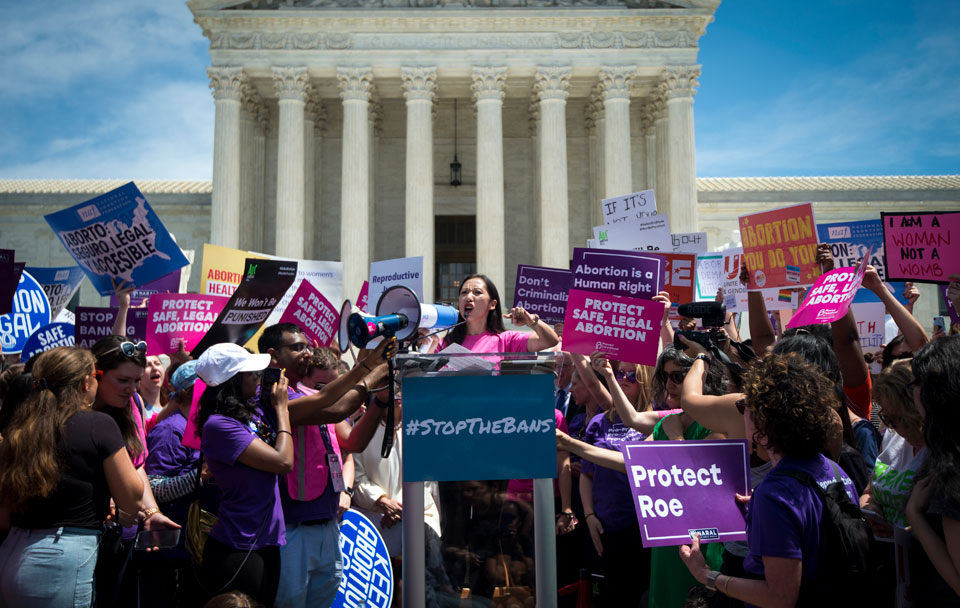
I sometimes hear activists say building and sustaining “the movement” is more important than achieving political and legislative victories. But what is the desired outcome of the movement if it isn’t, at least in the short-term, to improve the lives of working people through better legislation? The extreme right never pledges to build a movement without winning political power.
The extreme right’s political weapon is the Republican Party, whose right wing became dominant within the party with the election of President Ronald Reagan in 1980. There were other major rightward thrusts: Pat Buchanan’s Republican primary campaigns of 1992 (the “culture war”) and 1996 (as well as his 2000 Reform Party candidacy); the ascendency of Rep. Newt Gingrich, R-Ga., to House Speaker in 1995 and his Contract with America, released the prior year; the “shellacking” elections of 2010. Fueled by eight years of racial and national hatred towards President Barack Obama, the GOP of today is under the spell of the Tea Party movement, the Freedom Caucus, and President Trump.
The mantras have become never-ending tax cuts for the wealthy, dramatic increases in military spending, draconian social spending cuts (due to the ensuing budget deficits), hostility to the working class, animosity towards meaningful equality measures, and the perpetual reliance on the wedge issue of abortion.
President Dwight Eisenhower’s Republican Party at least funded infrastructure spending (though for trucks and cars, not mass transit). Republican members of Congress of the late 1950s and ’60s at least voted for the civil rights acts in higher percentages than did their Democratic counterparts (because of the Southern Democrats). The ghosts of those incarnations cannot recognize today’s completely backward version, and most Republican voters have probably been swept along with the currents without realizing it.
By the time of the next election, the GOP will have held the presidency for 12 of the first 20 years of this century, despite failing to win the most votes in two of those three victories. President George W. Bush and President Trump have packed all three levels of the federal courts—Supreme Court, U.S. Court of Appeals (“Circuit Courts”), and District Courts—with judges and justices serving the extreme right crusade.
For the past two decades, with or without a majority in the Senate, Republicans have controlled the confirmation of Republican and Democratic nominations. When the Republicans were in the minority during Obama’s first four years, they continually filibustered against his choices. Completely frustrated, the Democratic majority took a great risk and changed the rules about a year into Obama’s second term (November 2013), so a 60-vote supermajority was no longer needed to end filibusters preventing confirmation votes. The change did not include Supreme Court nominations.
When the Republicans took back the majority in the 2014 midterm elections, they stalled on many of Obama’s appointments, and the Democrats lacked the votes to approve them anyway. Justice Antonin Scalia, the intellectual force of the Supreme Court’s conservative wing, died February 13, 2016, nearly a year before the inauguration date for the 2016 presidential victor. McConnell extended his obstruction by refusing to hold hearings on the replacement choice, Merrick Garland, arguing that the 2016 elections were too close to charge ahead with the outgoing president’s preference.
After Trump’s surprise victory in 2016, Senate Majority Leader Mitch McConnell announced that the new simple majority rule would apply to Supreme Court justice nominations. The nomination of Neil Gorsuch, a proponent of Scalia’s outlook, was approved 54–45, soon outdone by the 50–48 confirmation vote of accused sexual assaulter Brett Kavanaugh. The conservatives’ 5–4 grip hardened considerably.
Trump’s two picks are the youngest (ages 51 and 54), and the two oldest are liberal Justices Ruth Bader Ginsburg and Stephen Breyer (ages 86 and 80). It is distinctly possible that Trump gets one or two more nominations before the 2020 election, and McConnell has vowed to honor any such choices, his posture about replacing Scalia be damned. The conservative majority could become 6–3 or 7–2 with possibly four of them under age 60!
This conservative majority has ruled for unlimited spending in elections, nullification of the Voting Rights Act preclearance requirements, and allowing grotesque gerrymandering by state governments. It is against the rights of labor unions, does not believe in legislative remedies for structural racism and discrimination, and will most likely end women’s abortion rights if given the chance.
However, the Supreme Court settles less than three percent of the cases brought before it. The tens of thousands of annual decisions of the U.S. Courts of Appeals, the level below the Supreme Court, make fewer headlines but are far more influential. McConnell, who kept many of these and District Court seats vacant during Obama’s terms, now openly gloats about filling them as fast as possible.
Reflecting their domination of the presidency, Republicans have appointed 51% of the 179 current Circuit Court judges to the Democrats’ 46% (nearly 3% are vacant). Trump, in his two and a half years, has appointed 42; Obama, in his eight years, received confirmation of only 55. Like all federal judges, these appointees serve for life—President Gerald Ford appointed one in 1975 who is still serving! Of course, each individual circuit court has its own makeup and liberal or conservative majority.
On the lowest level, the District Courts, when including senior judges, Republican-appointed choices slightly outnumber Democratic-appointed ones, 45.9% to 44.3%, with nearly 10% vacant. Incredibly, Judge Jack Weinstein, a senior judge serving the Eastern District, was appointed by President Johnson in 1967! Appeals on all District Court decisions first and usually reach only the Circuit Courts.
Currently, the U.S. Senate has 53 Republicans, 45 Democrats, and two independents. Thus, four seats must be “flipped” for the Democrats and independents to hold an outright majority. From what I have heard and seen, it is nearly inconceivable that any of the dozens of Democratic candidates would pick justices and judges worse than Trump. Activists and candidates who fail to see the differences between the major parties regarding nominations to the bench are acting as if working people don’t deserve better right here and now.
Senate seats, like all at-large offices, are extremely costly. Therefore, almost by definition, wrestling control of them and ending the Republican majority will necessarily involve moderate and centrist senators whose positive role in the battle for the courts should not be underestimated but who also will need to be pressured into liberal and progressive consistency. Centrist and progressive control of offices will change the basic questions being asked. Instead of wondering which industry regulations should be eliminated and how deep will be the social spending cuts, the debate moves to the issues of expanding the regulations and social spending. A very critical difference.
I would much rather be forced into pushing liberals and centrists to the left than watching a further deterioration of the legal system and remain on the defensive for another presidential term. Flippant attitudes about control of the White House and progressive litmus tests quickly become capitulation to the extreme right when it comes to the federal court system. After all, if control of the courts matters so little, why does the extreme right always fight for it?












Comments